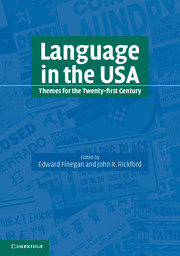Book contents
- Frontmatter
- Contents
- List of figures
- List of tables
- List of contributors
- Acknowledgments
- Foreword
- Editors' preface
- Part 1 American English
- 1 American English: its origins and history
- 2 American English and its distinctiveness
- 3 Regional dialects
- 4 Social varieties of American English
- 5 African American English
- 6 The Dictionary of American Regional English
- Part 2 Other language varieties
- Part 3 The sociolinguistic situation
- Index
3 - Regional dialects
Published online by Cambridge University Press: 05 June 2012
- Frontmatter
- Contents
- List of figures
- List of tables
- List of contributors
- Acknowledgments
- Foreword
- Editors' preface
- Part 1 American English
- 1 American English: its origins and history
- 2 American English and its distinctiveness
- 3 Regional dialects
- 4 Social varieties of American English
- 5 African American English
- 6 The Dictionary of American Regional English
- Part 2 Other language varieties
- Part 3 The sociolinguistic situation
- Index
Summary
Editors' introduction
This chapter treats regional dialects – a topic of tremendous interest to the general public. The first part is introductory, covering, among other things, the fact that no two people speak exactly alike but that regional speech is still a reality, for people from the same region do speak more like each other than like people from other regions. The US regional dialects developed in part from the separateness and isolation of the earliest colonial settlements and in part from the different mixtures of people who populated each region (Native American, German, African, and so on). Although some of the distinctiveness of the speech habits of the earliest settlers has been ironed out, broad regional patterns still remain, although they are constantly in flux, and they are to some extent abstractions.
The chapter draws extensively on maps and tables, and William A. Kretzschmar uses them to outline the boundaries and salient features of the main (Eastern) American English dialects in the mid-twentieth century, based on the work of legendary American dialectologist Hans Kurath. Kretzschmar shows how Kurath established isoglosses that demarcated dialects on the basis of people's familiarity with lexical alternatives like darning needle (Northern), mosquito hawk (Southern), and snake feeder (Midland), all of which refer to the ‘dragon fly.’ Subsequent analyses of pronunciation patterns essentially confirmed the regional dialect patterns that had been established on the basis of word use.
- Type
- Chapter
- Information
- Language in the USAThemes for the Twenty-first Century, pp. 39 - 57Publisher: Cambridge University PressPrint publication year: 2004
- 2
- Cited by

